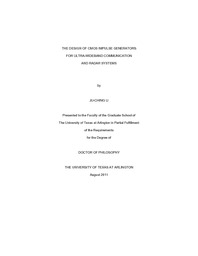
ATTENTION: The works hosted here are being migrated to a new repository that will consolidate resources, improve discoverability, and better show UTA's research impact on the global community. We will update authors as the migration progresses. Please see MavMatrix for more information.
Show simple item record
| dc.contributor.author | Li, Ju-Ching | en_US |
| dc.date.accessioned | 2011-10-11T20:48:27Z | |
| dc.date.available | 2011-10-11T20:48:27Z | |
| dc.date.issued | 2011-10-11 | |
| dc.date.submitted | January 2011 | en_US |
| dc.identifier.other | DISS-11306 | en_US |
| dc.identifier.uri | http://hdl.handle.net/10106/6159 | |
| dc.description.abstract | Impulse generators play an important role in the ultra-wideband (UWB) systems. Particularly in the transmitter, impulse generator performs an interface between input data and the antenna determining the overall performance of the transmitter. After the federal communication commission (FCC) revised the rules for UWB systems usages, the design of impulse generators has been pursued and yet challenging especially using CMOS technology. In this dissertation, three impulse generators are presented with analytical explanations, simulations, and measurements. First, the design and simulation of an impulse generator using TSMC 0.18 ìm CMOS technology is presented. The operating frequency band of the impulse generator is from 3.1 to 10.6 GHz for the application of UWB communications. The structure of the impulse generator is based on the current-steering digital-to-analog converter (DAC). The impulse generator has the feature of high-tunability and easy adoption of modulations. The simulation results show that the output of the impulse generator complies with the FCC regulations and has a power consumption of 27 mW at a 50 MHz pulse repetition frequency. Secondly, an impulse generator using IBM 90 nm CMOS technology for the application of 3.1 to 10.6 GHz UWB systems is proposed. The impulse generator has a simplex architecture using novel digital circuits and a compact passive band-pass filter (BPF). The measurement results show great consistency with the simulation results. The impulse generator has a center frequency of 5.8 GHz and consumes an average power of 0.9 mW at 200 MHz pulse repetition frequency. Finally, an impulse generator using TSMC 0.13 ìm CMOS technology is presented. The operating frequency band of the transmitter is from 22 to 29 GHz for the application of UWB vehicular short-range radar (SRR). The proposed design has a pulse-modulated carrier-based architecture. The simulation results show that the power spectral density of the impulse generator output complies with the FCC regulation with a center frequency tuning range of 800 MHz. The maximum achievable output swing is 1.14 V. The measurement results also show the uniformity with simulation results verifying the work. | en_US |
| dc.description.sponsorship | Jung, Sungyong | en_US |
| dc.language.iso | en | en_US |
| dc.publisher | Electrical Engineering | en_US |
| dc.title | The Design Of CMOS Impulse Generators For Ultra-wideband Communication And Radar Systems | en_US |
| dc.type | Ph.D. | en_US |
| dc.contributor.committeeChair | Jung, Sungyong | en_US |
| dc.degree.department | Electrical Engineering | en_US |
| dc.degree.discipline | Electrical Engineering | en_US |
| dc.degree.grantor | University of Texas at Arlington | en_US |
| dc.degree.level | doctoral | en_US |
| dc.degree.name | Ph.D. | en_US |
Files in this item
- Name:
- Li_uta_2502D_11306.pdf
- Size:
- 3.242Mb
- Format:
- PDF
This item appears in the following Collection(s)
Show simple item record


